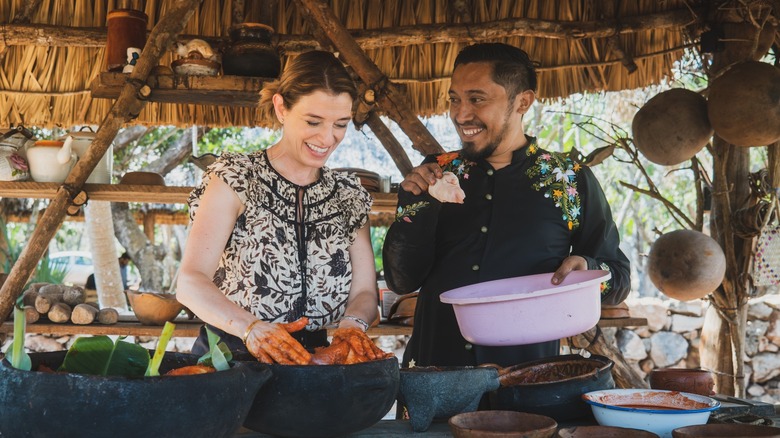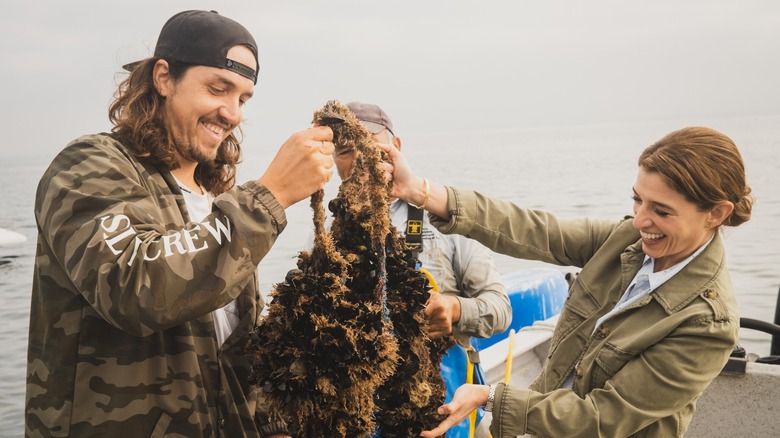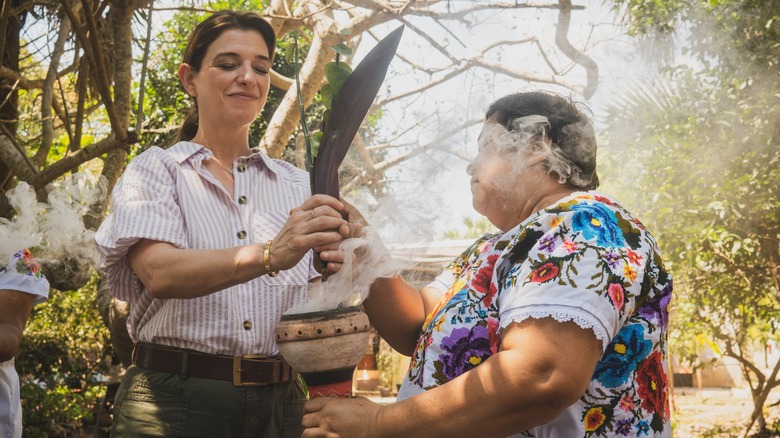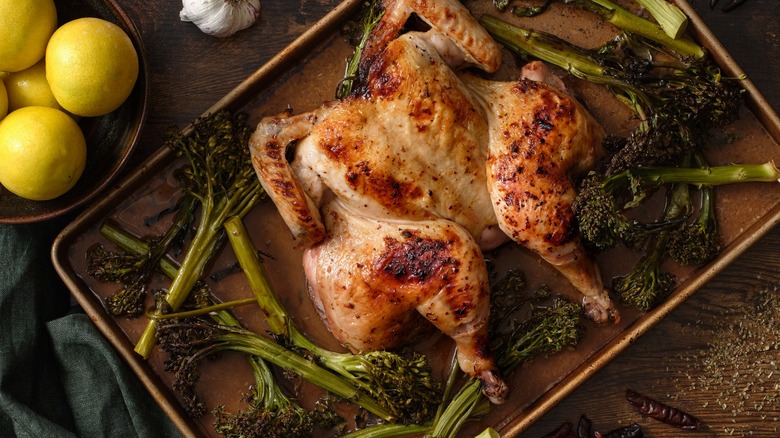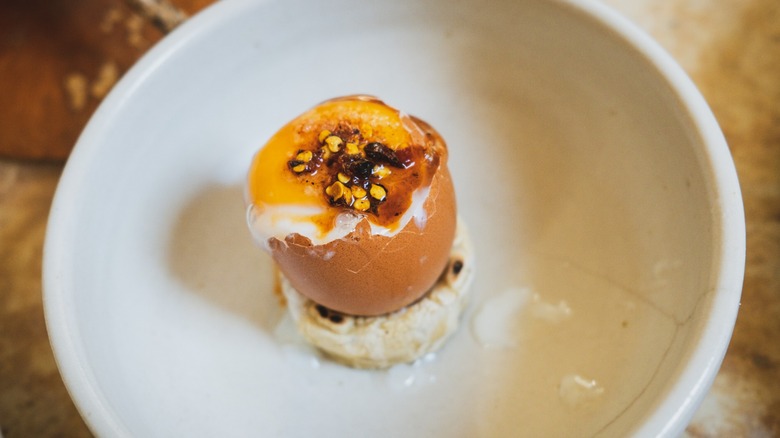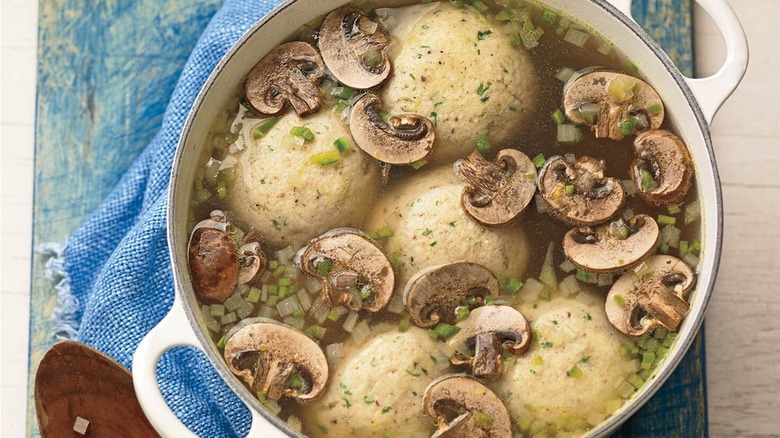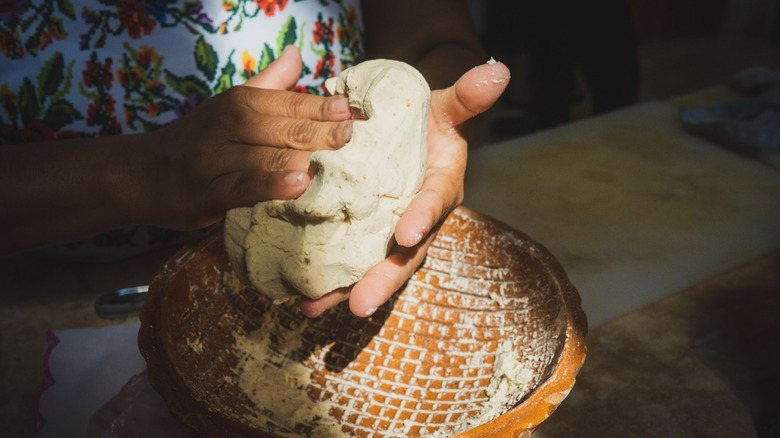Pati Jinich Wants To Bring The Flavors Of Yucatán To Your Kitchen - Exclusive Interview
Pati Jinich is a Mexican-Jewish chef, celebrated television host, and acclaimed cookbook author known for her James Beard Award-winning PBS series "Pati's Mexican Table" and "La Frontera," a culinary travel special that seeks to celebrate understanding, joy, and exceptional cooking from communities along the US-Mexico Border.
"Pati's Mexican Table", now in its 12th season, is an exploration of different regions of Mexico where Jinich spends time with local communities, studies the food, learns about the cultural history, and shares authentic recipes with her at-home viewers. This season of "Pati's Mexican Table", Jinich travels to Yucatán and becomes immersed in the rich Mayan history that's evidenced as much in the culinary traditions as it is in the people's spiritual connection to the land.
We recently connected with Pati Jinich to talk about how her identity as a Mexican-Jewish-American mother influences her culinary style. Speaking exclusively with Tasting Table, Jinich shares her favorite foods to eat at the Borderlands, her Mexican-inspired dishes for the upcoming Jewish holidays, and a few tricks to recreate the flavors of Yucatán cooking at home.
Cooking as culture identity
Both of your television series, "Pati's Mexican Table" and "La Frontera" explore the relationship between food and culture. What was the inspiration behind showcasing the two together and how has that relationship manifested in your own life?
I'm Mexican-born, Mexican-raised. All of my family is from Mexico and lives in Mexico City. I come from grandparents who, at different times and from different regions of the world, had to flee, and found their way to Mexico City. That's where they grew really deep roots. I've always been fascinated with sociology, history, and geography, and I wanted to contribute to a country that had given so much to my family and to be part of that community.
As a Mexican immigrant in the US, as a Mexican Jew in Mexico, as a mother to Mexican-American kids here in the US, in the kitchen, I was able to navigate all those identities and to honor all the foods that I inherited by being Mexican. I learned firsthand from my grandmothers, who came from Austria and Poland, how they were able to build a spiritual, emotional, and physical home in Mexico by way of weaving what they brought from where they came from with what they found in Mexico. I found myself doing the same thing here in the US.
I became so nostalgic for the tastes of home, for my family, and our traditions. I felt that the way that I was able to stay close to my roots, while at the same time growing roots here as a new immigrant in this country, was to make and share the foods that I love that I missed and that had nurtured me. That's how I got into cooking. Increasingly, my kitchen became this way where I was able to make sense of myself and my different pieces.
After almost a decade of going back and forth, between Mexico and the US, I started traveling to the border, and to the US-Mexico Borderlands and realized that if there were myths and preconceptions about Mexico and Mexicans in our food in the US, there was a place with even more prejudice and myths that didn't have an opportunity to speak as to who they are. [In "La Frontera"] we track the entire 1,951 miles of the US-Mexico Borderlands and live life with people from there. The show doesn't have any political bias. [It's about] wanting to understand what happens in a place where these two countries continuously meet, and what happens to the food and the culture, the incredible possibilities of what happens when two cultures and communities enrich each other in that intensity. Food has become this incredible vehicle that allows me to experience who we are as people today, by the way of how we eat, what we eat, and the stories behind it.
Eating at the Borderlands
At the Borderlands, the food is reflective of the melding cultures. What does that food mean to you and what are some of your favorite Borderlands dishes?
The people in the Borderlands are some of the most generous, kind, and hardworking people I've ever met. There's this pride in making things from scratch: the tacos that you eat, the burritos that you eat, the soups that you eat, the salads that you eat. There's an intensity to the ingredients at the border, and there's an intensity to the passion by which the food is cooked that I have not found in other places. That really translates to the experience of eating it. There's a lot of really close one-to-one communication. There's a lot of pride and passion that's put into the food that makes a huge difference.
There are so many incredible foods at the border: nachos, fajitas, taquitos, fish tacos, burritos, and Caesar salad — a Caesar salad eaten right in Tijuana, in the place where it was created. This is a salad that had its birthplace in Mexico and that so many people think is Italian. I believe it's the most well-known salad around the world, and it doesn't give due credit to its Mexican origin.
How does a Caesar salad in Tijuana compare to a Caesar salad in an Italian restaurant in the US?
[In Tijuana, a Caesar salad] is so intensely flavored. That's something that I found with all of the food at the Borderlands. Ingredients are super real and raw. I don't know if it's because many of the ingredients that are used are so local, but [it's evident] in the intensity of the food. They're not making the dressing for the Caesar salad once a week and storing it in the fridge. They're making it from scratch every time you order a salad. The bread is fresh and freshly toasted. The lettuce is insanely crispy. The limes are juicy and tangy. The garlic is pungent and fragrant. In Tijuana it's incredible — the most exquisite version of the Caesar salad.
The Flavors of Yucatán are different from the rest of Mexico
Season 12 of "Pati's Mexican Table" is an exploration of Yucatán in Mexico. Each of the previous seasons followed the culinary histories of different regions of Mexico. What about traveling through Yucatán has particularly affected you?
Each season, we go to a different region of Mexico and fully explore it. It's been incredibly humbling — continuing to grow roots in Mexico while learning more about Mexico. "Pati's Mexican Table" became an adventure of exploring the Mexico that I was yet to know.
For this season, we went to Yucatán and dug deep into the Maya culture and the unique intersection that exists between the Maya world, which is so prevalent in Yucatán and different from the rest of Mexico, where there were the Aztec, the Totonac, the different Native Mexican tribes. In Yucatán, it's the Maya, so you see chiles that you don't see in other places like the xcatic, chili guero, and there's a predominant use of habanero, [which is] super feisty, colorful, and citrusy. The oregano from Yucatán is much larger, more fragrant, and aromatic — it really smells like dried roses. It's much warmer than Mediterranean oregano, which is a little bit harsh and strong. It's also different from the Mexican oregano from Nuevo Leon, which is very woodsy.
The food from the Yucatán is very rustic, charred, and citrusy — with a lot of these flowery notes. There's a lot of food [in Yucatán] that's cooked underground. The tamales in Yucatán are typically wrapped in banana leaves [instead of] corn husks, and there's a lot of use of recado rojo or achiote paste. All of these ingredients you can now get in the US or anywhere in the world online. You can start making meals in your kitchen that suddenly magically bring in the Yucatán to your home wherever you may be living.
How can home cooks recreate the flavors of underground cooking in their own kitchens?
[I have a recipe] for cochinita pibil, which you can make with pork, turkey, or chicken. I put the meat in the oven, wrap it in banana leaves, and let it roast. [I use the banana leaves] to seal the meat, which replicates the smoky, intense, moist cooking from underground.
I also have a fast track take for cochinita pibil, or for chicken pibil, where you make the sauce by roasting a lot of the ingredients, like the tomato, the garlic, the onion — you char or roast them until the skin has practically burned, which is what they do in the Yucatán. The roasting and the charring push the ingredients to bring forward an intensity that is hard to find when boiling fresh ingredients.
If the tomatoes are sweet and you roast or char them, they will become that much sweeter, and juicier — the flavor comes forward that much stronger. You can make a seasoning sauce by charring or roasting the ingredients and also by toasting the spices. Then, you add the cooked chicken, turkey, or pork, and you pretty much get a similar thing, which is rich, exciting, and delicious without having to dig an underground pit in your backyard.
Simple delicious Mexican meals at home
What guidance can you share for home cooks looking to make a delicious meal at home with little time and simple ingredients?
I have a new chicken recipe that I made for this upcoming season in the Yucatán, which is easy to make and affordable. You buy a whole chicken in the store, and you spatchcock it, which means that you butterfly it, which is so easy. You remove the backbone, and flatten the whole chicken, which takes about one minute. Then, you make a citrus marinade, which is very simple, and you put the chicken in the oven for 45 minutes and it's cooked and beautiful. If you want a full meal, add broccoli or broccolini.
[Without too much effort], you come out with a full meal that has roasted chicken that's citrusy and delicious with broccoli or broccolini that you can cook in those same chicken and citrus sauces, too. Spatchcocking the chicken or butterflying the chicken is a great tip, because you're saving by not buying the already cut-up chicken, and you're also keeping a lot of the flavor using the skin and the bones. Butterflying the chicken is a great trick to know when you're getting the whole chicken, because butterflying makes it cook evenly, cook faster, and have that top crispier brown layer.
Speaking of making a full meal, what are your recommendations for preparing nourishing rice dishes?
I have so many rice recipes! I have a honey habanero and pea rice that's absolutely phenomenal; you can use jasmine or basmati. It's fragrant and cooks so beautifully. You cook the rice in either vegetable broth or chicken broth with a little bit of honey, and you cook habanero with a little bit of onion and garlic, and that makes the base. Then, you add peas at the end, and it's incredible. You don't need to just make white rice, or brown rice, or plain rice. You can enrich your different rice dishes by bringing in more chiles, and citrus, and underused ingredients like peas, which are so delicious and beautiful and are packed with nutritional flavor and that beautiful sweet taste.
I have another rice recipe that's inspired by the smoked meats of the Yucatán. In Yucatán, they smoke a lot of meats, a lot of pork, and chorizo, and longaniza. I make this black rice with chorizo, which is normal rice that I cook with a black bean broth. When you make black beans, save that broth and use it to cook your rice. The rice ends up with a beautiful color and a beautiful inky taste from the black beans. It's delicious! You add brown chorizo, and you cook the rice in the chorizo fat. I dress that with pickled onions.
Eggs are your most important brunch ingredient
What are your favorite ways to elevate brunch at home?
Eggs, eggs, eggs. I'm obsessed with eggs. I love eggs. I now not only use the fresh Eggland eggs but also the already hard-boiled Eggland eggs. They're so easy to do a chopped salad. I love chopped egg salad sandwiches. If you want to do a Sunday brunch, you can make different kinds of salads and you can put different fillings in — people can put them on bagels or sandwiches.
I also love typical Mexican style eggs. When we went to Yucatán, we ate some soft-boiled eggs that, instead of being soft-boiled in water, were soft-boiled in the ashes of a fire where tortillas were cooked. They were absolutely delicious. There are also Motulenos eggs, where you make sunny-side-up eggs that get baked in a sauce that has tomatoes and onion, a little habanero, peas, and diced ham. You eat it with caramelized plantains and refried beans. You don't need anything else. It's so extraordinary.
For this season [of "Pati's Mexican Table"], we also did a chaya scramble. The chaya is a beautiful green leafy plant, very similar to spinach or watercress. I made an easy scramble with caramelized onion, banana peppers, jalapenos, and chaya — but you could also use spinach or watercress. Then, you make a scramble and you add a little salsita and avocado on top, and you have a feast. There are so many ways to go. You can put the chaya scramble in breakfast tacos, or moms can make burritos for their kids. It's so easy to repurpose.
Many chefs have strong opinions about what should and should not be added to the base of an egg scramble. What is your professional take?
I love eggs so much. I love them straight. You don't need to add anything to them as long as you know how to cook them. The egg in a soft scramble is a beautiful thing. I add a little bit of salt and then whatever I'm mixing them with – you have to make sure that the pan is very hot. Once you pour the eggs in before you scramble, you reduce the heat to medium-low, so they cook slowly and gently thicken. Then, cook and scramble. You have to make sure that you don't overcook them so they don't become dry or rubbery. I love my eggs just like that. I don't add anything to them.
Mexican-inspired dishes for Rosh Hashanah
How do you celebrate your Mexican-Jewish identity in your cooking during the Jewish holidays?
I adapted my grandmother's matzo ball soup recipe. She makes hers with steamed mushrooms, jalapeno, and cilantro. I add toasted sesame seed oil and nutmeg to the matzo balls. They're so rich and flavorful. I also have a couple of brisket recipes, one with pasilla, piloncillo, and tomatillos that add a lot of dimension. I have a recipe for brisket in Chili Colorado, which is a rich dried chili base. I cook it low and slow.
For black pepper brisket, first, you sear it and brown it to get that nice crusty taste. Then, you use all those crusty bits and you braise it for a long time, long and slow. You take it out [of the oven], slice it, and cook it a little bit more with the sauce so that it falls apart.
For this Rosh Hashanah, I promised my kids I was going to make an almond and bitter chocolate soft challah. I'm still testing the recipe for that one. I'm playing a lot with challah this year. I love playing with new things. My grandmother used to make a thin crepe soup that I also want to make this year. Another popular recipe I make is a Gefilte fish in the Mexican style with a Veracruz sauce with rich tomatoes and pickled jalapenos.
Mexican ingredients in a store near you
Where are your favorite places to shop for Mexican ingredients?
There are so many places where you can now get Mexican ingredients. Kroger has a new Mercado brand where they have queso fresco, Oaxaca, corn and flour tortillas, and crema. They even have already cooked and shredded carnitas. Kroger is always a fantastic place to find things. The brands that I really love and have used since [I lived in] Mexico, you can now find everywhere, like La Costena salsas, or the avocados from Mexico that are so buttery and rich and creamy. If I'm looking for something very specific, say fresh or dried chiles, I will go to the Latino store, but increasingly, you can find more and more ingredients in mainstream stores, and some things you can even find online.
For tortillas, do you prefer to make yours from scratch or do you use store-bought tortillas?
I don't always make [tortillas] from scratch — only when I have the extra time, which means on the weekends, or if I want to treat my kids to special burritos with specially homemade flour tortillas. Goya has fabulous corn tortillas. I always have packs of tortillas at the ready, because I'm not going to have time every day to make 20 tortillas from scratch. I combine.
When I have extra time I do make them at home, or if I want to season them and flavor them with something. For the new season of "Pati's Mexican Table", I made herb corn tortillas where I mixed the masa with cilantro and chives. They're beautiful and delicious. As the tortillas cook, they get so powered and infused with the herbs inside of the masa.
Check your local PBS station's listings to find out when new episodes of "Pati's Mexican Table" air in your area.
This interview has been edited for clarity.

